Readers of my write-up of Chicken Inferno 2004 (whom I admire greatly for sticking around after such a ridiculous revelation) are familiar with our annual mid-summer fowl-flavored family festivities. For those who are unacquainted with this particular strain of madness, imagine the Burning Man festival taken out of the dusty desert and dropped into Pennsylvania farm country. Now, replace the giant human effigy with an enormous wooden chicken stuffed with hay and fireworks. Last but not least, burn it! Get the picture?
This year’s Chicken Inferno, our 7th annual, was an absolutely splendid affair. Friends and family convened from all over for an exuberant extended weekend of food, fun, and flames. But rather than dwell on the horseshoes or camaraderie, I’d rather use this forum to expound upon the avian activity surrounding our rural recreation.
The site of the Chicken Inferno straddles Pennsylvania’s Potter County and New York’s Allegheny County. Both areas are exceedingly agrarian with huge swathes of undeveloped woodland. Summer is short but intense and the forests and farms hum with wildlife. City birds like starlings, pigeons, and house sparrows do quite well, as always, but they seem a bit more feral in this environment. They, along with Black-capped Chickadee, Ruby-throated Hummingbird, American Robin, Gray Catbird, Mourning Dove, Blue Jay, Northern Cardinal, and the three common northeastern finches (House, Purple, and American Gold), have to compete for resources with less civilized species. New World sparrows thrive here in all seasons; the summer crop includes Song, Chipping, and American Tree Sparrow. This environment, with its multitude of barns and trees, supports huge flocks of derivatively-named swallows, but surprisingly, it also sustains Chimney Swift, even in the absence of many chimneys. As always, the month of July (what the locals fondly call summer) festooned telephone lines and tree limbs with Eastern Bluebird, Eastern Kingbird, Cedar Waxwing, Red-winged Blackbird, and Belted Kingfisher, beautiful birds all.
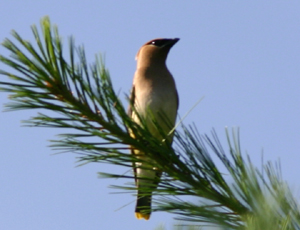
Cedar Waxwing
My growing experience in bird watching helped me dig a little deeper into this abundant ecosystem. Spotting Wild Turkey, though always a pleasure, is expected in Potter County. Viewing breeding warblers, on the other hand, is new for me in the Allegheny Highlands. Obviously, they’ve been there all along, but it’s only now that I’ve been able to find them, even stock species like Yellow, Black-and-white, and Common Yellowthroat. We also spied plenty of tyrant flycatchers, including the aforementioned kingbird, Eastern Phoebe, Eastern Wood-pewee, and an empid. I believe we’ve even identified this flycatcher correctly, but I’ll save the details of that deliberation for another day.
Of course, raptors and corvids terrorized the smaller species. American Crow and Common Grackle were plentiful everywhere. Red-tailed Hawk filled the skies, as did Turkey Vulture, which I’m told were virtually unheard of in Potter County until DDT was banned. Bright blue and orange American Kestrel were a pleasant surprise, as was an immature eagle at Letchworth State Park (the Grand Canyon of the East!) This imposing bird actually flew beneath us while we took in the commanding view of the Genesee River from atop a railroad trestle. Dumbfounded, I forgot all about my camera until the eagle was out of sight. The camera was equally useless when a large owl, probably a Great Horned, flew over my car at dusk. It might have come in handy if we ever spotted the Eastern Screech-Owl that disturbed our already suspect outdoor slumber, but the voluble varmint was well-hidden.
Of course, the bird everyone wants to hear about is the almighty Chicken itself, Gallus gigantus domesticus. Last year’s chicken was a true colossus, a thirty-foot titan that dwarfed all previous efforts. This year, we chose to focus on artistry and craftsmanship rather than sheer size.
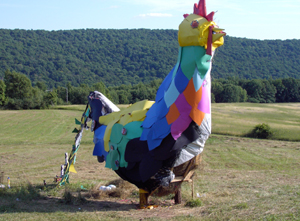
A giant among chickens
Our chicken was Thai-flavored, influenced by the style of old Siam. Experimenting with bold color added a new vividness to our chicken. As usual, we lashed firecrackers and pyrotechnics to the frame, stuffed a mortar in its mouth, and added a blazing pinwheel for the beast’s eye. This baby was built to burn. Believe me, it did!






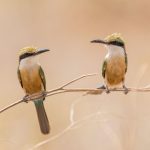
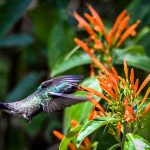
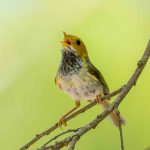
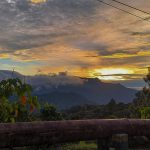



Leave a Comment